When we first arrived, we sat in a little waiting room for several minutes, before being asked to wash our hands in a little basin (just like washing one's hands before entering a shrine). Then we proceeded to the room in which the ceremony was going to be held. Everyone bowed to a scroll on the wall, a little tea cabinet, and a little hole in the tatami that held ashes to prepare coals for heating water. Then, we sat around the edges of the room...on our knees. Japanese people have a profound ability to sit on their knees for extended periods of time. We were about to discover how difficult it is to pull off such a feat.

The master of the ceremony brought out this beautiful basket with tools for stoking the coals. We were so impressed with the colors!
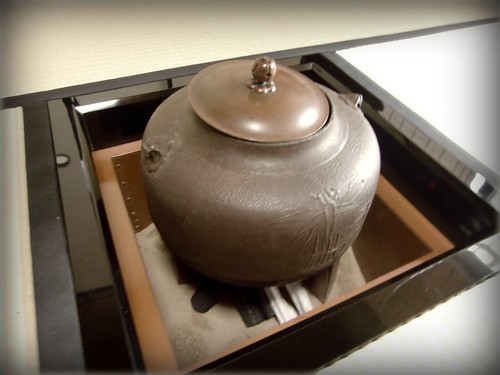
Next, she lifted the kettle onto the embers. When the lid was pushed to the side, we could hear steam sizzling out. Each kettle has a different sound, and different kettles are used depending on the theme of the ceremony. Our ceremony theme was "Early Spring."
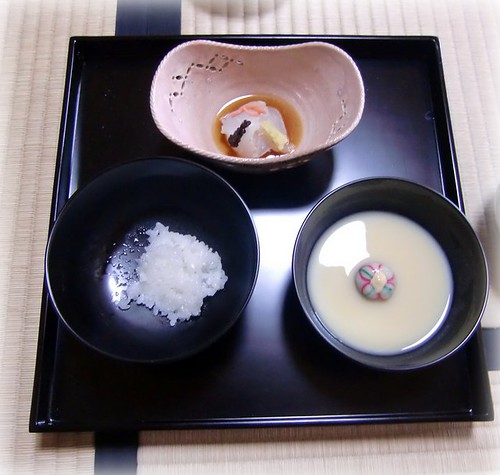
It was time for the first course (see above). We lifted the lids off the rice and miso soup at the same time, setting them aside. In the top bowl you can see raw fish. And see that beautiful ball in the middle of the soup? It's meant to look like temari, a beautiful toy ball made from the silk of kimonos. Don't be deceived by its beauty as I was--it had wasabi inside! (I'll have to share my previous, unfortunate wasabi experiences another time...)
Several more courses were brought out, including the most delicious salmon of my life. (I'm wondering if it was similar to this recipe for grilled miso salmon...) There were also periodic interjections of sake drinking ("A very expensive, classic brand," we were told). After a little dessert, it was time to bow to everything again and leave the room. At this point, we had been sitting for about three hours.
We enjoyed a brief respite from all that knee-sitting in the waiting room before washing our hands again and --ah! our poor knees!-- going back into the ceremony room. More bowing, then...more sitting. We were able take our minds off the pain a bit when silence filled the room and the master began her ritual. For the most part, the room was filled only with the sizzling of the kettle, the occasional soft grating of metal from the kettle lid, and the clicking of her tools.
See the thick, green matcha?
Notice her attention to every detail. There are over 100 rules for tea ceremonies, including that one must appreciate every nuance of the ritual (from the way the tea is prepared to the container in which it's served). We were served tea twice: the first time, thick green tea; the second time, thin green tea. Between servings, beautiful wagashi, or traditional Japanese confectioneries, were brought out (see below).
After the ceremony was complete, Chad and I were allowed to have a go at making the tea. Then, we bowed to the scroll, the tea cabinet and the kettle before exiting the room the final time. Overall, there weren't many differences between the informal and formal tea ceremonies, but the procedure took much longer in the formal version. Additionally, we endured a lot more pain for the beauty of it! In their entirety, the dinner and the ceremony lasted over four hours. With an 8000 yen price tag (about $80.00 USD), we probably won't be doing it again; however, we are certainly glad for the experience.
(Then again...that wasabi killed me!)
Osaki ni! (After me!)






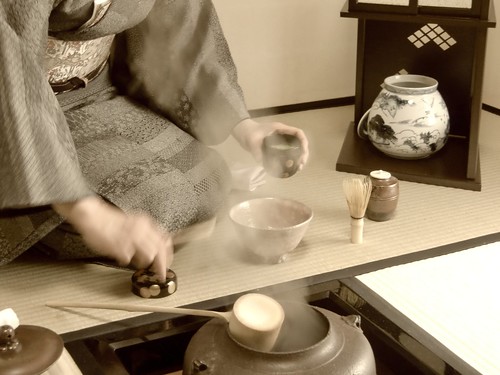
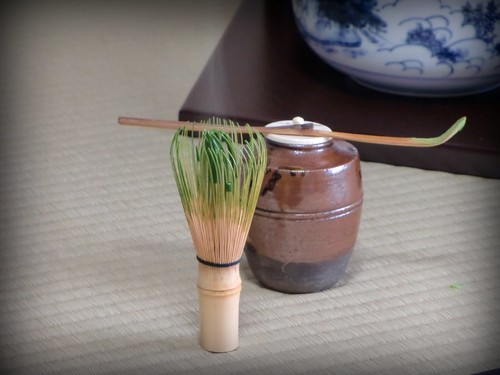
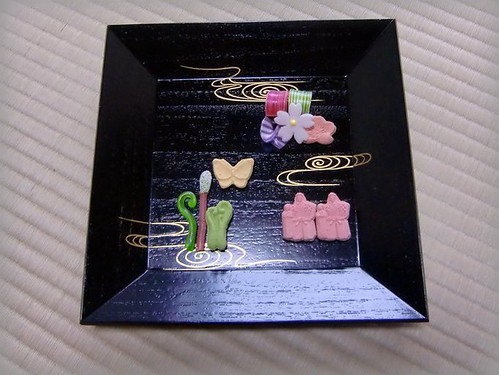


2 comments:
Goodness. My knees hurt just reading this! :)
What a great experience though!
I wish I could go to Japan :P Looks like you had a good time but DAYUM my knees would be sore.
Post a Comment